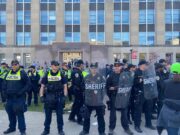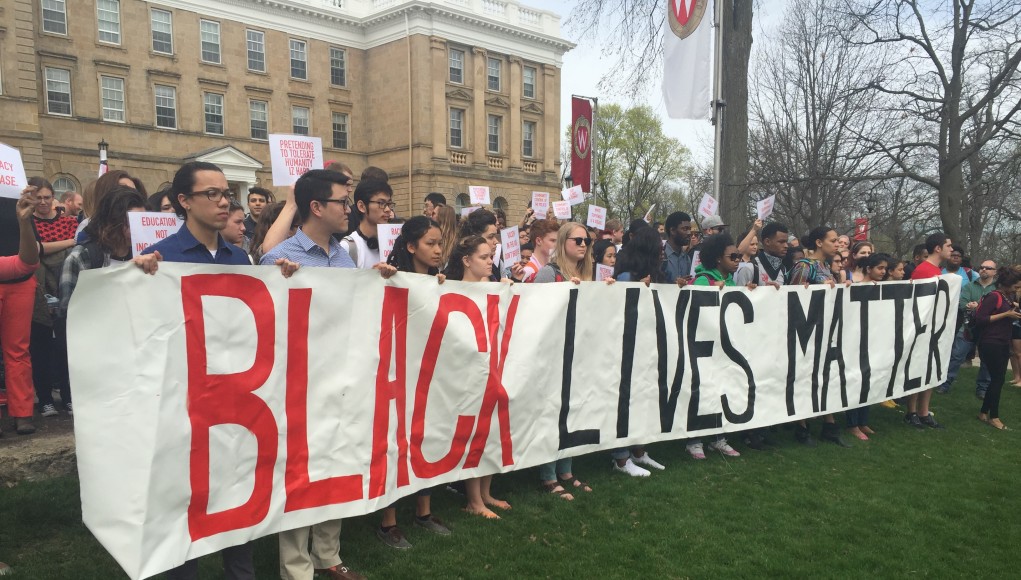The recent event at UW-Madison where two UWPD officers entered an Afro-American studies class and arrested UW-Madison senior King Shabazz, also known as Denzel McDonald, in connection with anti-racist graffiti on the UW-Madison campus raised many questions about the role of police in campus life.
While that classroom arrest of a student over anti-racist graffiti has left many wondering about the priorities of campus police, and the role, jurisdiction, and oversight of the department, it’s important to note incidents that have happened elsewhere in the nation.
In 2015, a University of Cincinnati police officer shot and killed an unarmed black man, Samuel DuBose, during an off-campus traffic stop and now faces murder charges. A report later found that the campus police chief at the time misled administrators about his knowledge of aggressive off-campus traffic stops conducted by his department.
UC-Davis has spent $175,000 dollars to sanitize its online image and clean online search results since a 2011 incident (pictured below) in which a college police officer was filmed indiscriminately pepper-spraying peaceful protestors.

Gary Schultz, a former administrator at Penn State University, was charged with “perjury, conspiracy, endangering the welfare of children and obstruction in connection with the Jerry Sandusky child sex abuse scandal.” At one time, as vice president for finance and business, he oversaw the campus police department.
Most colleges and universities operate police departments like the ones at UW, Penn St., UC Davis, and Cincinnati. However, oversight from the larger community — including faculty, students, and staff — is often unclear or lacking.
A brief overview of campus police
In 1894, Yale hired two off-duty New Haven police officers to walk patrol on campus. This marked the first instance of a college-sanctioned police force. Today, it’s hard to imagine a college campus without some sort of law enforcement agency.
According to the Bureau of Justice Statistics(BJS), 95 percent of four-year colleges with more than 2,500 students operate a law enforcement agency. These agencies employ nearly 32,000 people. Ninety-two percent of these colleges employ sworn police officers, 94 percent of which are permitted to use a sidearm.![]()
College police departments are growing faster than student enrollment. Between the 2004-05 and 2011-12 school years, student enrollment at four-year colleges and universities that BJS surveyed increased by 11 percent, while full-time law enforcement personnel on campus increased by 16 percent.
Originally, most campus police departments were “public safety” departments — walking patrol, providing security and crowd control, and sometimes helping with maintenance.
That changed as college enrollments grew after WWII and campuses experienced more unrest and social activism and militancy in the 1960s and 70s (See: Modern Campus Police: An Analysis of Their Evolution, Structure, and Function, The. Am. J. Police, 1992.) By the 1980s, campus police were becoming more professionalized and accredited.
Though often perceived as not “real” cops, campus police usually have legal authority from local or state statute to operate like traditional police forces. This includes authority to make arrests and carry firearms. Most campus police officers today receive the same training and attend the same police academies as cops in municipal departments.
Since the mid-1980s, the number of campus-based agencies changing their names from “public safety” departments to “police departments” has risen substantially, and now, most function fully like municipal police departments. Most college police departments report to an official in central administration.
Issues of oversight and transparency for campus police
The role of police in certain municipalities has come under heightened inquiry from the general public as well as the U.S. Department of Justice after several high-profile killings of unarmed black men and women. Campus-based police operate with an equal amount of authority, but under reporting lines that can appear less vetted and less transparent than their municipal counterparts.
Many campus police departments operate at the bequest of (or in the interest of) the campus chancellor, provost, or other senior administrator. For instance, At UW-Madison, the police department reports to the Vice Chancellor of Administration and Finance. System-wide, the UW Board of Regents holds the statutory authority to employ campus police departments.
While other campus departments and services — from the arboretum to the library – receive the attention of shared governance bodies on campus, it’s less clear if faculty, students, and staff provide the same kind of oversight for campus police. For example, there is no Faculty Committee on public safety or policing at UW-Madison. If it’s necessary to have a Faculty Senate “Committee on Committees,” doesn’t it seem reasonable to have a shared governance committee (with faculty, students, and staff) that provides at least some oversight of the police department?
Students expect campus police to help keep them safe, but to do so without interfering unnecessarily with their lives as students. The events at UW-Madison last week raised many questions about the role of police in campus life.

About the UW-Madison incident: On April 14th, two UWPD officers entered an Afro-American studies class and escorted out a UW-Madison senior, King Shabazz, also known as Denzel McDonald. Soon after, they arrested him in connection with anti-racist graffiti on the UW-Madison campus. Shabbaz faces 11 counts of vandalism and one count of disorderly conduct.
Given the content of the anti-racist/anti-white supremacy graffiti, and placed in context of several instances of overt racism directed at students of color on campus this semester, many in the campus community have justifiably wondered why this particular act of vandalism was treated with such urgency by law enforcement. Why did it warrant a classroom arrest, while other incidents did not? It brings into question the ability of campus representatives to combat racism here and the extent to which systematic change on campus is aided or hindered by those acting on behalf of the university, such as the campus police department.
About campus police policy: How often do campus police enter classrooms to apprehend students during class or during the course of their education more broadly? The chancellor and chief of police issued statements soon after the arrest and public outcry, both expressing concern. The chancellor’s letter says that policy and procedure was not followed in this instance, and the chief said that classroom arrests are uncommon. But what exactly is the police policy regarding the use of classrooms as the site of apprehension?
Questions about community input and oversight: Have faculty, staff, and students had the opportunity to provide input on such policies or are they left to the discretion of the campus police chief, chancellor, and outside police agencies to set and administer alone? The university has historically operated under a model of shared governance, yet there appear to be no faculty or shared governance committees dedicated to providing input on campus police actions and policy. And many in the community feel the time has come not just for oversight, but also for community control of police.
Are faculty, staff, and students content with the current level of oversight of campus police? Based on a letter signed by hundreds of faculty, students, and staff, it appears many questions remain.
(Disclosure: I signed the letter.)




























